September Issue - On Writing
Themed on writing featuring authors from all over the world.
Themed on writing featuring authors from all over the world.
You also want an ePaper? Increase the reach of your titles
YUMPU automatically turns print PDFs into web optimized ePapers that Google loves.
INK DRIFT MAGAZINE<br />
Three Tips for Thriller Writers<br />
Archana Sarat<br />
Thriller spells action<br />
Something needs to happen as soon as you open a thriller novel. If it happens in the first scene, it<br />
is good. Action in the first paragraph is better but action in the first line itself would be excellent.<br />
For instance, this is the opening sentence of my book, Birds of Prey, ‘Anton hoped the bloody<br />
bastard would slip on one of the ragged stones.’ While a few well-meaning folks were scandalised to<br />
read the phrase ‘bloody bastard’ on the first line, the legendary Shri. B. S. Raghavan, who has worked<br />
directly under the first three Prime Ministers of our country, agreed to launch the book only because<br />
of that first sentence. So, don’t be scared to throw in a dead body or two there.<br />
Please do not speak about the weather or the locale unless you plan to pull them into the action<br />
too. Jerry Pinto does this beautifully in ‘Murder in Mahim’. It starts off with this sentence, ‘Bombay<br />
doesn’t do night.’ After Tolstoy’s opening sentence in Anna Karenina, this is my most favourite<br />
opening sentence in literature. The sentence not only speaks about the city, which plays a major part<br />
in the novel, but also speaks about it in action. Bombay doesn’t do night.<br />
Thomas Harris doesn’t do a gripping first sentence in ‘Red Dragon’. Damn, he doesn’t even<br />
do a gripping opening scene! Do you know why? He is building up the atmosphere for the second<br />
scene which is sure to make your stomach lurch. Thomas Harris could have easily interchanged those<br />
two scenes while structuring his novel but he doesn’t because he knows that it wouldn’t have the same<br />
impact that it has now. And that brings me to the second point…<br />
Pay attention to structure<br />
Unlike a few novels that ramble on without any clear storyline, a clear-cut story is a prerequisite for a<br />
thriller. There must be a clear conflict and a rational solution for the same, without any ambiguity. You<br />
cannot introduce your murderer to the audience after they have read more than half the book. To take<br />
it one step further, a thriller novel needs to be divided into scenes and each scene needs to logically<br />
lead to the next. If you are interested to know more about structuring a novel, I would suggest reading<br />
these three books:<br />
i) Aristotle’s - Poetics<br />
ii) Joseph Campbell’s - The Hero with a Thousand Faces<br />
iii) James Scott Bell’s - Plot and Structure<br />
Since my novel dealt with two different points of view, and because there had to be a balance between<br />
them, I had to carefully structure the novel. The fact that I had panted my way through the first draft<br />
made sure that the story was all over the place. So, I made index cards with a scene for every card and<br />
arranged them (on the floor) in various ways to see how best it would work. <strong>On</strong>ly after that became<br />
clear, did I start rewriting the next draft of Birds of Prey. Whether you do it on paper, cards or excel<br />
doesn’t matter, but give a thought to how you structure your book. Many authors are excellent storytellers<br />
that the process happens organically. However, most thriller writers give a careful thought to<br />
the plot and structuring of their book.<br />
PAGE 17<br />
www.inkdrift.com














